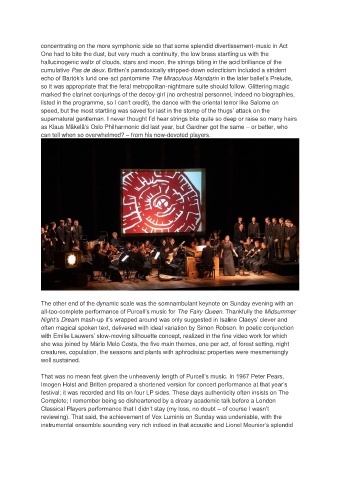Page 536 - Media Coverage Book - 75th Aldeburgh Festival 2024
P. 536
concentrating on the more symphonic side so that some splendid divertissement-music in Act
One had to bite the dust, but very much a continuity, the low brass startling us with the
hallucinogenic waltz of clouds, stars and moon, the strings biting in the acid brilliance of the
cumulative Pas de deux. Britten’s paradoxically stripped-down eclecticism included a strident
echo of Bartók’s lurid one-act pantomime The Miraculous Mandarin in the later ballet’s Prelude,
so it was appropriate that the feral metropolitan-nightmare suite should follow. Glittering magic
marked the clarinet conjurings of the decoy-girl (no orchestral personnel, indeed no biographies,
listed in the programme, so I can’t credit), the dance with the oriental terror like Salome on
speed, but the most startling was saved for last in the stomp of the thugs’ attack on the
supernatural gentleman. I never thought I’d hear strings bite quite so deep or raise so many hairs
as Klaus Mäkelä's Oslo Philharmonic did last year, but Gardner got the same – or better, who
can tell when so overwhelmed? – from his now-devoted players.
The other end of the dynamic scale was the somnambulant keynote on Sunday evening with an
all-too-complete performance of Purcell’s music for The Fairy Queen. Thankfully the Midsummer
Night’s Dream mash-up it’s wrapped around was only suggested in Isaline Claeys’ clever and
often magical spoken text, delivered with ideal variation by Simon Robson. In poetic conjunction
with Emilie Lauwers’ slow-moving silhouette concept, realized in the fine video work for which
she was joined by Mário Melo Costa, the five main themes, one per act, of forest setting, night
creatures, copulation, the seasons and plants with aphrodisiac properties were mesmerisingly
well sustained.
That was no mean feat given the unheavenly length of Purcell’s music. In 1967 Peter Pears,
Imogen Holst and Britten prepared a shortened version for concert performance at that year’s
festival; it was recorded and fits on four LP sides. These days authenticity often insists on The
Complete; I remember being so disheartened by a dreary academic talk before a London
Classical Players performance that I didn’t stay (my loss, no doubt – of course I wasn’t
reviewing). That said, the achievement of Vox Luminis on Sunday was undeniable, with the
instrumental ensemble sounding very rich indeed in that acoustic and Lionel Meunier’s splendid

